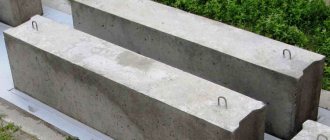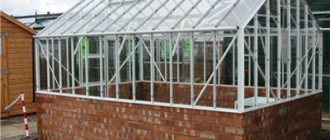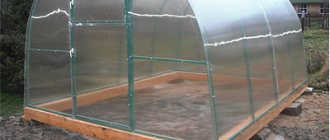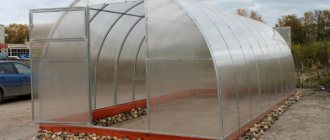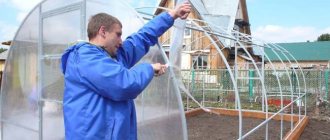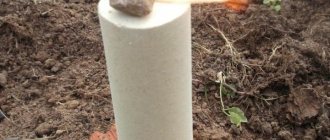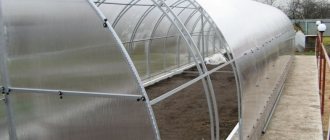Greenhouses and greenhouses are temporary structures, and every gardener knows that it would be impractical to erect such a structure on a monolithic concrete foundation.
The current material for the foundation for a greenhouse will be timber. This is a durable and reliable material that will withstand the finished structure, and if desired, it can be moved to another location next year.
In order for the foundation to be reliable, it is necessary to become more familiar with the conditions of use of the material and the nuances of constructing the structure.
Advantages and disadvantages
Each base material has its own pros and cons. To begin with, it is recommended to consider the positive features of a timber foundation:
Minimum consumables. To secure a wooden base to the ground, you will need a small amount of hardware and parts, which will help reduce the construction budget.- Smooth geometry. The timber has smooth edges and precise dimensions. Thanks to this, it is possible to greatly reduce and simplify some of the construction processes.
- Fast construction. When the foundation is ready, you can immediately begin building the greenhouse frame - there is no need to wait for shrinkage and drying, as happens when using concrete and stone materials.
- Manufacturability. The wood is technologically advanced, which ensures easy fixation of the base components to each other, as well as trouble-free fastening of the frame to the foundation.
- Quick repair. If damage occurs, such a base can be lifted with a jack and parts that have become faulty can be replaced.
- Environmental friendliness. The timber is a safe material for humans, as it does not emit harmful substances into the atmosphere.
Note! Another plus is that such a base can be easily transported to another place on the site.
Despite the abundance of advantages, there are also some disadvantages to this design. For example, the service life is too short. One can argue with this statement, because houses made of timber have been standing for decades, and the foundation can always be repaired and continue to be used.
Also, some argue that such a base cannot support a large mass, but in this case this function is not needed, since greenhouses made of polycarbonate or film do not have much weight.
How to treat boards for garden beds against rotting: simple and effective methods
Boards are increasingly being used to arrange garden beds in summer cottages. Although this design option fits perfectly into the overall plan of the land, it also has disadvantages. During operation, the wood undergoes a rotting process, as a result of which the service life of such beds becomes short. It is for this reason that it is recommended to pre -treat the boards for the beds, and then proceed to further work. Since there are a large number of compounds designed to treat boards against rotting, it is necessary to approach the selection process as carefully as possible.
Folk remedies
You can treat wood for garden beds against rotting using folk remedies, of which there are a large number today. A feature of using these methods is their reasonable cost.
treat wooden beds using the following effective preparations:
- a mixture based on propolis and sunflower oil;
- solution based on copper sulfate;
- bitumen mastic;
- heat treatment of boards;
- firing process.
In order to prepare a special mixture for processing, it is worth taking sunflower oil and propolis in a ratio of 3:1. These components are mixed until a homogeneous mass is obtained, and then applied to the boards using a sponge. Using this method, it is possible to treat and protect the building material used for beds from the appearance of bacteria and fungus.
Antiseptics
Another option for treating boards for high beds from rotting is to use an antiseptic. Thanks to antiseptics, the surface of the boards is reliably protected from cracking; also, during use, mold does not appear on the building material, and the rotting processes that have begun are stopped. In addition, thanks to this treatment against rotting, the structure and pattern of the wood does not undergo changes.
But not all antiseptics suitable for treating boards for garden beds against rotting are harmless to human health, which is also recommended to be taken into account before making a purchase. Today, there are several popular antiseptics that are recommended for use by many specialists and experienced gardeners.
Water-soluble compounds. This option is the easiest, allowing you to cover the boards for the beds from rotting. Using water-soluble components, it is possible to process any wood, regardless of the species, but before starting work, it is recommended to first clean the surface of the material from dirt, dust and other building mixtures. It is recommended to repeat this procedure several times, and the interval between application of layers can vary from 2 to 4 hours. After the boards are processed, they need to be given 12 hours to dry completely. In addition, this approach will avoid deformation and cracking of the building material.
- Oil compositions. Antiseptics belonging to this type are considered technical type oils. Such compositions are recommended for use in regions where there is a high level of humidity. With the help of oil antiseptics, it is possible to provide reliable protection of boards for beds from the process of rotting. However, it is worth taking into account the fact that such antiseptics are toxic. These types of impregnations increase the combustion of Honor of the material; a rather unpleasant odor appears, which cannot be gotten rid of for a long time. Despite these disadvantages, most consumers, when arranging high and warm beds using boards, prefer oil antiseptics. This choice is due to the fact that during operation the composition is not washed off from the surface of the wood, and it also has antiseptic properties.
- Combined formulations. Such antiseptic compositions, after treatment against rotting, can provide a reliable level of protection for wood from the appearance of fungus, pests, and mold. In addition, building material processed using the combined composition does not undergo rotting during operation. In order to achieve the desired level of protection, it is recommended to apply about 2-3 layers of the composition to the boards for beds. This processing option is perfect for boards that will be used to create high and warm beds. A special feature is the complete safety of the substance.
READ DIY flower made from a wooden board
When treating against rotting using antiseptic compounds, you must be as careful as possible, and you should not forget about the application technology. If you follow the instructions supplied by the manufacturer, the service life of more than 10 years is guaranteed. It is not recommended to skimp on antiseptics, as safety should always come first.
Terms of Use
The greenhouse must be installed on a frame, and if timber was chosen as the base material, then it is worth remembering several conditions for its use:
the weight that such a foundation can support is from 70 to 120 kg;- fastening of parts must be provided in such a way that in the future it can be disconnected and the greenhouse can be moved to another location;
- the greenhouse frame must ensure the rigidity of the entire structure;
- the timber must be treated appropriately to protect the soil inside from being washed away by rain;
- raw materials must be treated with antiseptics and impregnating materials to avoid rotting, attacks by rodents and insects;
- processing of the material should take place on a separate site to avoid chemicals getting into fertile soil;
- all cuts, places where beams and boards are fixed must be treated with antiseptics - this is done at the assembly site.
Important! To process the material, not only impregnations and antiseptics are used, but you cannot do without them. If you abandon the processing stage, then with constant rain and watering inside the greenhouse, the timber frame will become unusable very quickly.
Recessed option
A greenhouse or greenhouse is built on a wooden foundation even if it is necessary to grow vegetables and seedlings in the winter. It is usually buried 1 meter. This makes it possible to save on resources, taking advantage of the warmth of the earth. Despite the fact that the area of the walls transmitting light is reduced, this option allows you to save fuel.
The technology of the polycarbonate surface version differs not only in the design of the frame, but as for the base, it is created much more powerful. Using logs or semi-tips, semi-logs. Having removed the bark and carried out pre-treatment.
In these basics, the work goes like this:
- They excavate the soil to a given depth and level the walls. Lay a waterproofing layer of roofing felt on the outer wall.
- Drive the pointed end of the log into the ground around the perimeter. Pre-treating them with bitumen or mastic.
- Along the lower and upper parts of the finished log walls, staples 40-50 cm long are driven in and tightened.
- Level the top edge using a chainsaw. Then they place the top beam, screwing it to the ends of the logs.
- They compact the base near the pillars.
Tip: Every 5th log should be 50-60 cm longer than ordinary ones. For example, the burial height is 1000 mm. The row post is 1400 mm long, and the corner and intermediate post is 1800 mm long.
To build greenhouses made of wood or polycarbonate, you can use any of these technologies. The main thing is to determine the direction and purpose of the greenhouse. And to build a base from wood means choosing the optimal ratio of price and service life.
Related article: Driving piles
Types of timber foundations and selection criteria
Since a timber foundation is the most economical, it is chosen by most gardeners. But it is not enough to choose only the material; it is also important to choose the type of base. They come in these types:
- Tape. It can be deep or shallow. For a greenhouse, the second option is just right. It is a monolithic frame-ribbon made of wood. This option is reliable and economical.
- Columnar. It is represented by monolithic wooden pillars, which are installed in the corners of the future greenhouse. Such pillars are lowered into the ground to a shallow depth.
To choose the right option, you should pay attention to the type of soil. If it is rocky and not heaving, then you can safely choose pillars made of timber. For other types of soil, it is better to give preference to the tape option.
Digging soil in a greenhouse in the fall
The soil in the greenhouse in the fall is teeming with various microorganisms. Our task is to get rid of those that can harm the plants. To do this, dig up the soil so that bacteria, weeds and pest larvae die after subsequent treatment with drugs. The digging depth is about the bayonet of a shovel.
In addition to microflora, residues of insecticides and fertilizers accumulate in the soil, so once every 2-3 years the top layer of soil (25-30 cm) should be replaced with fresh one. Old soil can be placed in compost, scattered on garden beds, or taken outside the site.
If you planted green manure, do not mow them, but only trim them slightly. By spring they will rot and become a good fertilizer for the soil.
Sources:
https://sch112.ru/raznoe/obrabotka-dosok-chem-obrabotat-derevo-i-doski-chtoby-ne-gnilo-zashhita-ot-gnieniya-ognezashhita-narodnye-metody-obrabotka-drevesiny-ot-gnieniya- i-vlagi.html https://b-online.ru/malye-formy/chem-obrabotat-doski-dlya-gryadok-ot-gnieniya-prostye-i-effektivnye-sposoby.html https://www.ogorod. ru/ru/now/greenhouse/14509/Chem-obrabotat-teplitsu-osenyu-ot-bolezney-i-vrediteley.htm
Choosing a wood type
The timber should be made from selected wood, but you should pay attention to its species.
Pine has an expressive pattern, but this is not the main thing when choosing a species for building a foundation.
This material has a density of 520 kg per cubic meter, it is rigid and elastic. Treating pine with impregnations will not be a problem. This is the most common lumber from which timber is made.- Spruce has a density of 430 kg per 1 cubic meter. It is light in weight, but has good stiffness and elasticity. It also lends itself well to treatment with chemical compounds. This raw material has a higher thermal insulation value and a low resin content. It is because of this that spruce is more susceptible to rotting than pine.
- Larch is often an alternative to oak, as it has good rot resistance. It is chosen for this advantage for foundations: larch is not afraid of dampness. It is strong, durable, widespread throughout the country - it is easy to find in almost any construction market, and larch is also low in cost.
- Cedar pine is not often used, since the timber made from it is expensive. The wood is dense and easy to process. This material is more suitable for decorative finishing. Than for the base for a greenhouse.
On a note. Considering the above, we can conclude that the best options for the base will be larch and pine.
Preparing a greenhouse for tomatoes in the fall
In order for tomatoes to grow healthy and strong, it is important to tidy up the greenhouse soil. This is especially true if you grew tomatoes in a greenhouse this year and they were affected by late blight or other diseases. You can replace the top layer of soil, but this, alas, does not eliminate the possibility of infection in the future. Therefore, for the best effect, plant green manure in the greenhouse: rye or alfalfa. They will disinfect the soil, saturate it with nutrients and make it looser and more fertile. Seedlings planted on such soil will begin to grow faster!
What else needs to be done in the greenhouse in the fall so that the tomatoes enjoy it there in the spring? Since plants have a fairly branched root system, they need the most loose and permeable soil possible. Sifting the soil, as well as adding humus, compost and vermicompost will help improve these indicators. Tomatoes do not like acidic soils, so if there is such a problem, be sure to deacidify, for example, add 300-500 g of lime per 1 sq.m.
Adding an article to a new collection
The last harvest has been harvested, but the dacha work is not finished yet. The question arises of how to disinfect a greenhouse in the fall and tidy up the soil in order to destroy pests that are preparing for winter and pathogenic microflora.
It seems obvious that treating a greenhouse in the fall against diseases and pests is a vital procedure. But some summer residents put it off until spring, limiting themselves only to removing plant debris and digging up the soil. Meanwhile, prevention is very important. And often such negligence leads to the fact that seedlings from the first days of planting in the ground suffer from pests and diseases. That's why we've put together simple and valuable tips on how to treat your greenhouse in the fall after harvest, so you can get the job done.
Caring for a greenhouse in the fall includes cleaning, washing the structure, and cultivating the soil. Also, after harvesting, it is worth preparing the soil for planting seedlings and applying fertilizer. Let's take a step-by-step look at the work in the greenhouse in the fall, paying special attention to disinfection procedures.
All types of greenhouses and greenhouses are subjected to treatment.
Material processing
Before using timber from the timber to lay the foundation, it is recommended that it be properly treated. It is worth considering several important nuances:
- the antiseptic must be intended for external use: compositions for internal use will be washed off at the first precipitation;
- the impregnation should be “friendly” with polycarbonate and not damage it during use;
- there should be no poison in the impregnation: it can penetrate the soil and infect the plants;
- the most optimal composition is water-based, which creates an invisible film on the surface of the raw material and protects it from rotting;
- Sometimes, instead of ready-made products, you can use a folk method: burning with a blowtorch, heated bit or machine oil works well.
You can also use copper sulfate - it is harmless to plants. For processing, each part is soaked in a solution and left to dry, but without exposure to sunlight. Drying usually takes about 3 weeks.
Finnish method
You can increase the resistance of wood to the harmful effects of moisture, pests and rot by using the Finnish method. You can make the composition yourself. To do this you need to take the following components:
- 1.6 kg of lime;
- 800 g flour;
- 400 g salt;
- 1.5 kg of vitriol;
- 10 liters of water.
Cooking method:
- Combine flour and cold water until a thick consistency is formed, then combine the resulting composition with the remaining ingredients.
- Heat the finished paste over low heat, mix well and cool slightly.
- Treat the surface of the wood with a warm solution.
- After absorption and complete drying, apply another layer. The degree of protection is regulated by the thickness of the applied layers, which ensures the suppression of all kinds of influences that can destroy the wood.
This treatment will protect the board for 15 years. But you need to take into account that when heated, copper sulfate releases dangerous substances. Therefore, it is advisable to use the designed beds exclusively for growing flowers. Otherwise, vegetables grown near wooden structures treated with this composition, when consumed by humans, can cause problems in the functioning of the digestive system.
What will you need for the job?
To arrange the supporting structure, you need to prepare the following tools:
shovel;- roulette;
- level;
- hammer;
- drill;
- screwdriver;
- jigsaw or saw;
- screwdriver.
You also need to purchase screws or other fasteners that will secure the frame. The materials you will need are timber of the selected species; it should have a moisture content of about 22%.
There are also nuances when choosing the thickness of the boards. For example:
- For a lightweight greenhouse frame, 5x5 cm beams are suitable.
- For a medium-sized structure on metal rods, it is important to take a beam of 5x10 or 5x15 cm.
- If the greenhouse frame is created from profile pipes or thick wooden boards, then it is better to take raw materials with a cross-section of 10x10 or 15x15 cm.
Detailed instructions for installing a greenhouse on timber: diagrams and photos
Installation as follows:
- A ditch 30 cm deep and 20 cm wide is dug along the perimeter of the future building. The bottom of the trench is compacted, removing irregularities, and covered with a mixture of gravel and crushed stone. As a result, a layer 10–15 cm high is obtained. The gravel and crushed stone are covered with a layer of sand of the same thickness. The depth of the trench should be reduced enough so that the timber laid in it comes halfway out of the pit. The created sand cushion is carefully pressed. The bottom and walls of the trench are covered with waterproofing material.
Digging a trench for the foundation of the greenhouse, leaving no unevenness at the bottom
They prefer to fasten the foundation beams using the “half-tree” method
To fix the frame to the base of the beams, special metal supports are used
The wooden base of the greenhouse was placed on stones, and the frame was made of metal profiles
Installing a greenhouse on a supporting structure
As an example, you can consider 2 options for step-by-step instructions: one for a strip foundation, the other for a columnar foundation.
To tape
Construction begins with clearing the site and marking it out. Pegs are inserted around the perimeter in the corners where the greenhouse will be. Then string is pulled between them. Also, do not forget that the timber must be treated with an antiseptic. Next step by step:
- Dig a trench under the base 10-20 cm deep.
- Make a sand cushion. Geotextiles are placed under the sand.
- Beams are laid on top of the geotextile.
- The corners are connected using dowels or corner plates.
- The beams are covered with roofing felt on top to protect them from moisture.
Attention ! Some builders recommend using roofing felt instead of geotextiles, which are wrapped around after laying the timber. But this method does not protect against moisture, because it has open joints, and does not prevent the development of mold. Moreover, due to lack of ventilation, the wood will rot faster.
The method of attaching the greenhouse to the foundation depends on the type of frame:
If the frame of the greenhouse is made of wood, then it can be fixed using special supports of a closed or open type. Vertical posts must be supported with slopes.- If the frame is metal, then it is attached to the beam with anchors. When the metal frame of the greenhouse is assembled, cellular polycarbonate is installed on it using special screws or another selected material.
On the pillars
This foundation is the most economical and simple. It is produced using the following technology:
- Clearing and marking the area around the greenhouse area.
- Digging a hole for wooden posts: their diameter should be 1.5 times the diameter of the beam.
- Filling the bottom with sand - then it needs to be watered and compacted tightly.
- Installation of a cross treated with an antiseptic on the sand.
- Installation of support pillars - pre-treat them or cover them with waterproofing.
Such a base will last for several decades with proper impregnation. The frame and covering of the greenhouse are also screwed onto the poles, depending on the raw materials used.
Disinfection of a greenhouse in the fall
The tomatoes, cucumbers and peppers that you grew this year are often affected by various diseases in greenhouse conditions. Remember how long you struggled with late blight and root rot? It's time to stop the proliferation of pathogenic microflora! To do this, we have prepared a clear plan for how to cultivate the soil in the greenhouse in the fall.
When using soil chemicals in greenhouses in the fall, be sure to use personal protective equipment: respirators, safety glasses, rubber gloves, aprons, etc. After treatment, wash your hands and face thoroughly and rinse your mouth. It is not recommended to stay in a closed greenhouse being processed for more than 10 minutes. After treatment, the greenhouse should be ventilated.
Soil preparation in the greenhouse in the fall should begin in late September - early October and be completed before the onset of stable frosts. If all the work is carried out on time, then by spring the building will be free of parasites, mold and mildew. In addition, the structure will last longer, and working in a clean and well-maintained greenhouse is much more pleasant.
How to treat a greenhouse against late blight in the fall. Copper oxychloride (40 g per 10 liters of water) and a 3% solution of Bordeaux mixture have proven themselves to be effective. You can also use Abiga-Pik, Consento, Revus, Fitosporin or other fungicidal drugs.
How to treat a greenhouse against powdery mildew. The fungicides Gamair, Topaz, Fitosporin, Quadris, Tiovit Jet, etc. will cope with the hidden fungus.
How to treat a greenhouse against fusarium. Fusarium wilt is difficult to treat, and the fungus that causes the disease is also difficult to treat. The following drugs will come to the rescue: Trichofit, Gamair, Previkur Energy, Oxychom, etc.
How to treat a greenhouse against cladosporiosis (brown spot). Use Pseudobacterin-2, Fitosporin, Polyram, Hom.
READ What wallpaper goes with white brick
How to treat a greenhouse against root rot. Biological products Baktofit, Pseudobacterin-2, Gamair, Planriz, Trichodermin will help.
Copper sulfate (100 g per 10 liters of water) can be used in a greenhouse in the fall as a universal disinfectant. It will also serve as an excellent fertilizer. But it should be applied no more than once every 5 years, because... the substance increases the acidity of the soil. The soil can be shed with a prepared solution or sprayed. A sulfur bomb will also help clean the greenhouse from all types of diseases and pests.
If there were no manifestations of diseases during the season, then it is enough to improve the soil in the greenhouse in the fall. Fitosporin, Trichodermin, Baktofit, Baikal EM-5, Planzir, and other similar drugs can handle this.
For the best effect, the greenhouse treatment should be repeated 2 weeks after the first procedure or after the interval specified in the instructions for the drug.
Advantages, disadvantages of wooden supports
On a wooden base, you can build both small greenhouses, used for beds and flower beds, which are easy to move without disassembling, and large stationary greenhouses. It is necessary to analyze the advantages of timber-based greenhouses.
The main advantages of lumber:
- low price compared to other building materials;
- speed of assembly and dismantling;
- mobility of small structures;
- availability of materials and basis for repairs;
- simplicity in calculations and construction;
- the ability to move the greenhouse to maintain crop rotation;
- spring cultivation of seedlings, after which the greenhouse is dismantled or transferred to the next section of the garden;
- does not emit toxic compounds that affect grown plants.
Despite all the positive aspects of a wooden support, it has a number of disadvantages that affect the construction and use of finished greenhouses. Such greenhouses require special protective measures against fungal infections of wood, insects that feed on wood fibers, as well as insulation from moisture, which causes rotting of the material.
If the wood is not treated with the necessary additives, this can affect the crops being grown, spreading pathogens among them, or poisoning the air in the greenhouse with their waste products, which will lead to a slowdown in growth, or the accumulation of toxic compounds in the fruits.

